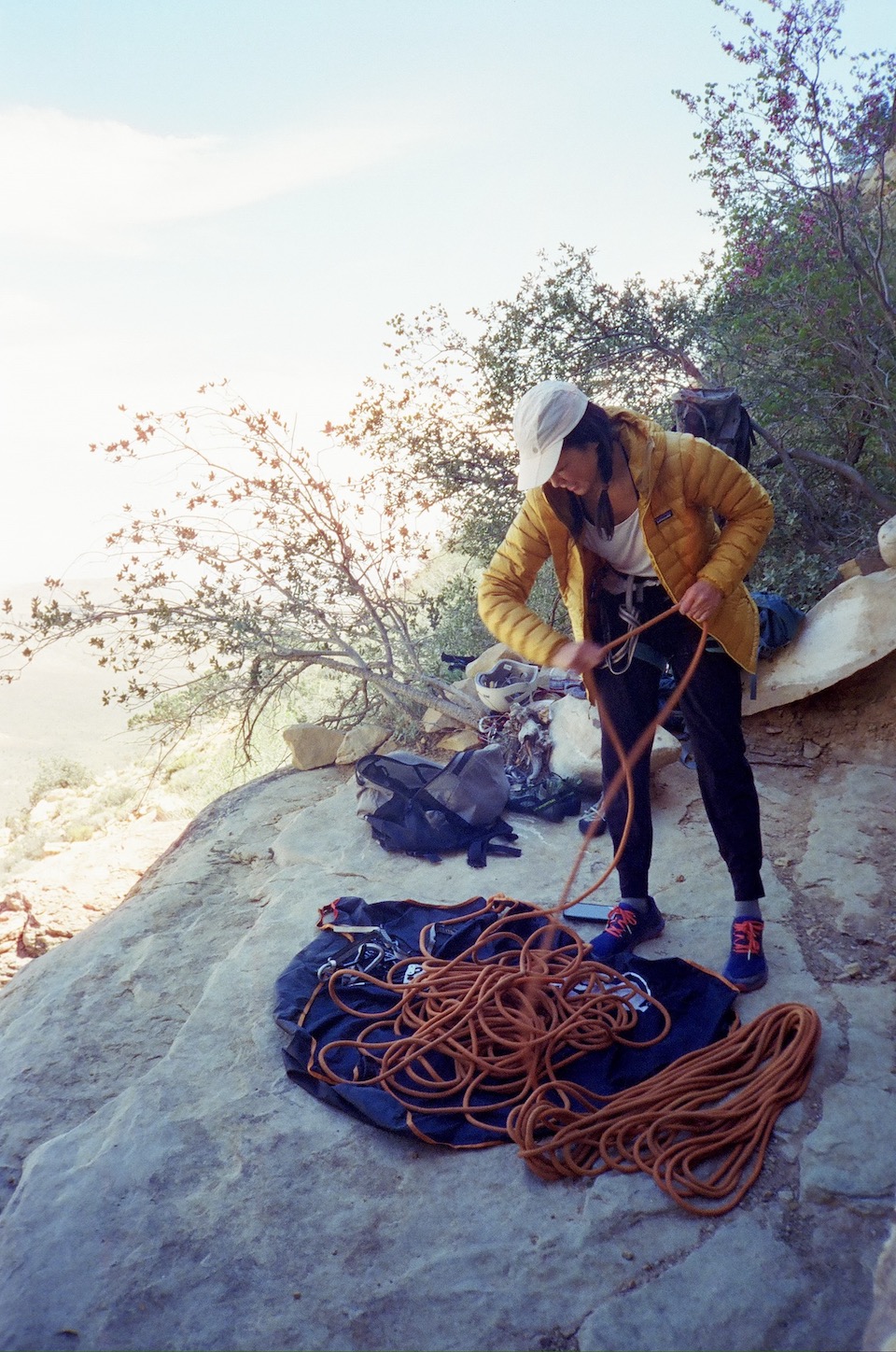Vera Koo’s daughter, Shane, also is an adventurer, a chip off the old blocks since both of her parents, Vera and Carlos, are fanatic sportsmen. In this post, Shane describes what it’s like to return to the sport of climbing, and about how not only the technology has changed, but the entire social aspect of it. We think you’ll find this a fascinating update about climbing in the 22nd Century. ~The Editors
Sponsored by Vera Koo
Finding a climbing partner is as easy as swiping on Tinder these days.
OK, so it’s not exactly Tinder, but I imagine sifting through profiles on Mountain Project or Facebook is what a dating app feels like.
After my daughter was born, I had much less time for climbing, but over the last few years, climbing has once again become a bigger part of my life. My daughter developed an intense interest in climbing and that was the impetus to get back into it. Then, through a friend, I was invited to a climbing trip in Red Rock Canyon, Nevada. I joined a group of about 20 strangers, ranging in ages from their mid-20s to mid-50s. I’m 47, and I hadn’t been on a real climbing trip since I was in my 20s. I didn’t know anyone, but we used a group chat to connect.

Now, technology makes finding a climbing partner more instantaneous. One day you’re connecting online, and the next you’re climbing with a new partner. What you lose in familiarity, you gain in accessibility, but keep in mind, convenience can come at a tradeoff.
When I started in this sport, having a climbing partner was like being in a monogamous relationship. You found a partner and stayed with them for years. This brought comfort and security. You and your partner knew each other inside and out, and I knew my belayer had me in any fall.
I learned the hard way, after all. I begged experienced climbers to teach me and to take me on climbs. I had to climb harder and smarter so that I wasn’t passed up for a better climber. But on this trip, a lot of the climbers had taken classes and learned from guides. They never had to beg and accommodate. They had condensed years of my experience into a handful of weekends. They learned multiple techniques in a matter of days, whereas I gradually accumulated them over hundreds of climbs.

The way things are done now often freak me out! For example, there’s this major shift in the use of belay devices. In roped climbing, there’s a climber and a belayer, who stands on the ground, takes in and feeds out rope. The belayer secures the rope with help of a special device that creates friction. I used a belaying device called an ATC. Now, almost all belayers prefer a device called a GriGri, a self-locking assisted braking device. It is a great concept, but the device creates difficulty in feeding out rope to a lead climber. In turn, the belayer needs to override the device to pay out rope as needed. This move compromises the safety mechanism but also creates a habit that can result in overriding the safety at the wrong time.
In theory, the GriGri makes climbing safer, but it also can breed improper, sloppy technique that puts the lead climber at risk. Nothing harmful happened during this trip, but more than once I spied a belayer completely take their hands off the safety end of the rope, a move that would have easily ended any climbing relationship in the past. But with all these newcomers, would I want to trust someone to an ATC or simply use a GriGri?
Don’t get me wrong, I don’t have an aversion to new equipment, but unexpectedly with my old climbing gear, I heard comments like: “I’ve never seen one of these in real life!” These climbers had fancy, lightweight gear, and my gear was gawked at like items in a museum.
I learned on a majority of passive gear, such as hexes and nuts. After all, they were cheaper, lighter and, I thought, you could more easily see if the gear would hold in a fall. Cams where a luxury and used sparingly. Today’s climbers seem to eschew passive gear, while using cams and totems almost exclusively. They even squeeze cams in deep, sometimes overdoing it, and the cams are nearly impossible to remove at times. But the overall approach makes sense. Newer climbers know it is better to leave gear behind than to take a risk. A life is worth more than any $100 cam. They might not climb as hard, but, in a way, they climbed more sensibly.

I learned new techniques and climbing philosophies from these fresh climbers. But maybe more importantly, I also learned that I needed to overcome some of my own hard-earned biases. Just because my way of doing things is good and has been validated over years, it’s important to be open to new approaches that are, in fact, just as valid. The sport is evolving, and I believe that the more we connect to the outdoors, the more we love and cherish it. So, ultimately, making climbing more accessible to anyone who wants to try it can only better this world.
As a salty old lady, I don’t love all the changes, but I know without a doubt, the sport of climbing is improving in more ways than one.
The Women's Outdoor News, aka The WON, features news, reviews and stories about women who are shooting, hunting, fishing and actively engaging in outdoor adventure. This publication is for women, by women. View all posts by The WON